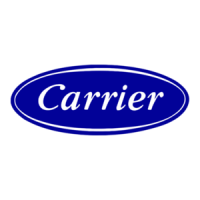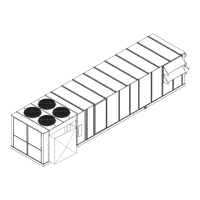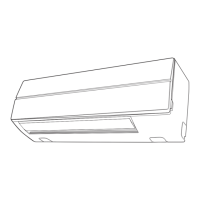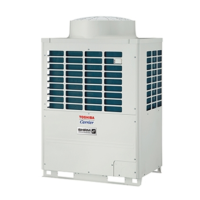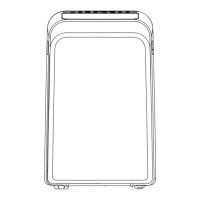VARIABLE AIR VOLUME OPERATION — The constant
volume control becomes variable volume control with the
addition of a thermostat. The thermostat enables the control
to sense changes in the room temperature, override the vol-
ume controller and reduce the unit flow to match the ther-
mostat setting. If room temperature rises, the bellows will
bleed, increasing unit flow until the thermostat is satisfied. If
room temperature falls, the bellows will inflate, decreasing
the unit flow until the thermostat is satisfied.
Preliminary System Check — Perform air balanc-
ing and control system checkout before building is occupied
but after conditioned spaces are reasonably clean. The high
induction ratio of 37HS Moduline® diffusers can produce
ceiling smudges within a few days if construction dirt is present.
Before starting system, thoroughly check the air handling
apparatus and controls. Verify that the fan static pressure
control is operating properly so that starting the fan without
airflow at terminals will not cause duct damage from
overpressure.
1. Check fan and system controls for proper hookup.
2. Be sure that all dampers, including fan inlet, fan outlet
and outdoor- and return-air dampers, have proper free-
dom of movement. Lubricate as required.
3. Check fan belts, motors, sheave alignment and fan wheel
rotation. Check bearings for proper lubrication. Refer to
fan manufacturer’s recommendations.
4. Be sure that fan final filters are in place. If not, accu-
mulated dirt will be distributed throughout the system and
can accumulate in unit or fall into space. Dirt can also
disrupt air terminal operation.
5. Be sure that fan, coil, filter section and ductwork are clean
and free of any construction debris.
6. Remove protective tape from all diffusers.
Initial Start-Up
GENERAL CHECKOUT
1. Start the variable volume air-supply system and obtain
suitable supply-air temperature and pressure. If design speed
of supply fan is based on a diversified block load, close
zone fire dampers or set Moduline thermostats at highest
setting to obtain sufficient pressure at terminal being
balanced.
2. Check the air terminal system for open control loops. Noise
and excessive airflow at unit may indicate disconnected
tubes, loose plugs or fittings. Correct the problem before
beginning detailed checkout below.
SERVICE
Gaining Access to Control Area —
On standard
units, center diffuser is not removable. Remove ceiling tile
or reach through nearby light fixture to gain access to
controls.
TROUBLESHOOTING
General —
If system design parameters have been met,
such as ductwork size, airflow rate, etc., improper operation
can often be traced to leaks or obstructions. The following
paragraphs describe the general procedure for checking for
leaks or obstructions.
Before performing any check, be sure that plenum pres-
sure is a minimum of 0.75 in. wg and that supply-air tem-
perature is 50 to 60 F and room temperature is 70 to 80 F.
Checking for Obstruction — If there is an obstruc-
tion, the unit fails to respond either partially or completely
to thermostat changes, but does not show any indication of
a control circuit leak.
Check the bellows pressure at each inlet and outlet. Pres-
sure at every point in bellows circuit should be the same.
The obstruction may be kinked control tube.
Checking for Leaks — The center diffuser of these units
is not removable. Gain access to unit controls by raising ceil-
ing tile.
1. Master units can be identified by means of thermostat
lever extending below diffuser. See Fig 40.
2. Disconnect slave from master by disconnecting the inter-
unit tubing. Mark tubes clearly to assure proper re-
assembly. Cap ports on master unit to isolate it. Then
move thermostat lever to full red (warm) setting and ob-
serve whether unit shuts off.
3. Check for cracked plastic parts, loose or cracked tubing
or a loose filter. Remove filter and check that filter open-
ing is not obstructed; then replace filter.
4. Remove thermostat/volume controller assembly.
Attach Magnehelic gage to bellows connection with rub-
ber tube. (See Fig. 41.) Blow into tube until unit shuts
off. Hold tube so that no air escapes. Dial on Magne-
helic gage dropping or the opening of the diffuser slot
discharging air will indicate a bellows leak. If after ap-
proximately 30 seconds no leak is detected, the bellows
are satisfactory.
5. If unit appears satisfactory, replace the thermostat/
volume controller assembly and connect it to the unit.
See Control Installation section page 22.
6. Test whether master unit (isolated, without slave units)
will control. If no control, check duct pressure as de-
scribed in the section below.
7. If master unit controls properly, add one slave unit, mak-
ing sure air is flowing from both sides of diffuser. If both
units control, add another slave; and so on down the line.
8. If control is lost by adding a new slave, check for loose,
cracked or disconnected tubing. Isolate that slave and
cap all bellows ports. Attach a Magnehelic gage to one
port and blow into it. The Magnehelic gage will be needed
to detect a leaking bellows.
9. If possible, check bellows pressure at each unit by at-
taching Magnehelic gage tubing to a bellows port for
2 to 3 minutes after stabilization takes place. Record
values.
10. Take duct readings with all units connected and oper-
ating. Reference To Check Duct Pressure section below.
To record data on slave unit, remove high-pressure port
plug (Fig. 34) and insert Magnehelic gage tube into open-
ing. Replace plug after test.
11. If units are still not controlling, check inter-unit control
tubing for possible holes, breaks or pinching between
the 2 units where control apparently was lost.
29
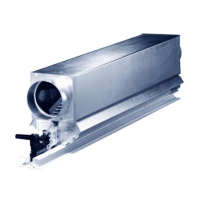
